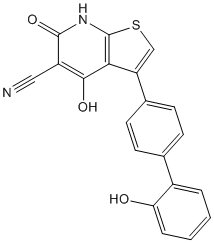All AbMole products are for research use only, cannot be used for human consumption.

A-769662 is a potent, reversible AMP-activated protein kinase (AMPK) activator with an EC50 of 0.8 μM.A-769662 displays selectivity towards β1 subunit-containing heterotrimers. A-769662 not only inhibits fatty acid synthesis with an IC50 of 3.2 μM but also decreases plasma glucose and triglyceride levels in vivo. The addition of A-769662 to mouse embryonic fibroblasts or primary mouse hepatocytes stimulates phosphorylation of acetyl-CoA carboxylase (ACC), effects that are completely abolished in AMPK-alpha1 (-/-)alpha2 (-/-) cells but not in TAK1 (-/-) mouse embryonic fibroblasts. Phosphorylation of AMPK and ACC in response to A-769662 is also abolished in isolated mouse skeletal muscle lacking LKB1, a major upstream kinase for AMPK in this tissue. A-769662 directly prevents the alpha (1)-isoform of the Na (+)-K (+)-ATPase which is purified from rat and human kidney cells in vitro with IC50 of 57 μM and 220 μM, respectively. Suppression of the Na (+)-K (+)-ATPase by 100 μM ouabain decreases sodium pump activity and cell surface abundance, similar to the effect of A769662 (A 769662; A-769662), without influencing the phosphorylation of AMPK and ACC.
| Cell Experiment | |
|---|---|
| Cell lines | MEF cells |
| Preparation method | Treating or not cell viability of MEF cells with A-769662 is performed as follows: harvesting cells by trypsinization and incubating with 0.5 mg/mL RNase and 50 μg/mL propidium iodine at room temperature in the dark; analyzing cell viability by flow cytometry using a FACScanto flow cytometer, using an excitation laser at 488 nm and a propidium iodine fluorescence detection at 600 nm. Cells are harvested by trypsinization, collected by centrifugation, washed in PBS and fixed overnight in 80% ethanol at -20 °C to determine the proportion of cells in each phase of the cell cycle. Subsequently, these fixed cells are centrifuged to remove the fixative and incubated for 20 minutes in the dark at room temperature in PBS containing 0.5 mg/mL RNase and 50 μg/mL propidium iodine. Flow cytometry analysis is performed as above. Using the MODFIT progra to determine the proportion of cells in G1, S, and G2 is determined . Using a camera to take Cell culture pictures at the indicated times coupled to an inverted microscope with a 20 × objective. |
| Concentrations | 300 μM |
| Incubation time | 24 hours |
| Animal Experiment | |
|---|---|
| Animal models | Sprague Dawley rats |
| Formulation | A-769662 is dissolved in DMSO |
| Dosages | 30 mg/kg |
| Administration | Administered via i.p. |
| Molecular Weight | 360.39 |
| Formula | C20H12N2O3S |
| CAS Number | 844499-71-4 |
| Solubility (25°C) | DMSO 35 mg/mL |
| Storage |
Powder -20°C 3 years ; 4°C 2 years In solvent -80°C 6 months ; -20°C 1 month |
| Related AMPK Products |
|---|
| Aldometanib
Aldometanib (LXY-05-029) is an orally active aldolase inhibitor. |
| SAMS
SAMS peptide is a specific substrate for the AMP-activated protein kinase (AMPK). |
| Marein
Marein has the neuroprotective effect due to a reduction of damage to mitochondria function and activation of the AMPK signal pathway. |
| Malvidin-3-O-arabinoside chloride
Malvidin-3-O-arabinoside chloride ameliorates ethyl carbamate-induced oxidative damage by stimulating AMPK-mediated autophagy. |
| AMPK activator 12
AMPK activator 12 is a potent AMPK activator and GDF15 inducer. |
All AbMole products are for research use only, cannot be used for human consumption or veterinary use. We do not provide products or services to individuals. Please comply with the intended use and do not use AbMole products for any other purpose.


Products are for research use only. Not for human use. We do not sell to patients.
© Copyright 2010-2024 AbMole BioScience. All Rights Reserved.
